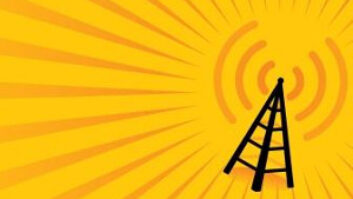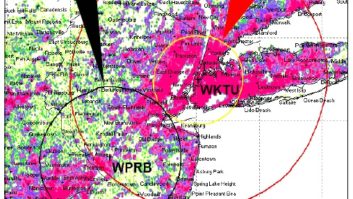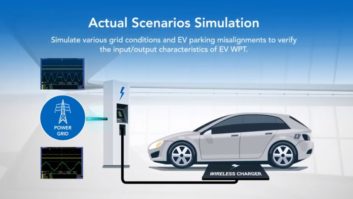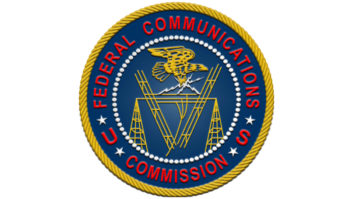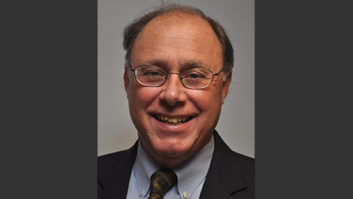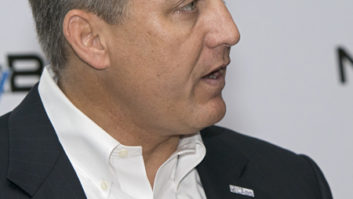If iBiquity Digital’s projections hold true, 50 percent of vehicles sold in the United States this year will include HD Radio, and within a few short years, vehicles with HD Radio will become the norm. Our listeners are buying vehicles with it every day. As time goes on, the discrepancy between an FM station’s analog and digital coverage areas will become more noticeable to your listeners, advertisers and sponsors.
I feel the radio industry is unprepared for how inadequate FM digital coverage at –14 dBc can be. It’s time to reevaluate digital power level restrictions so that more stations transmitting an FM HD Radio signal can experience enhanced coverage.

I-287 New Jersey Corridor, WHTZ, −20 dBc, 1/4-Wave Antenna FIELD DATA
Field observations and drive testing involving elevated FM IBOC stations have led me to this conclusion.
The FCC rules governing elevated FM IBOC power levels have been in effect for four years, long enough to add to the industry’s collective digital radio knowledge base.
Back in 2002, when the agency authorized IBOC transmission, the initial power level for the digital carriers was 1 percent of the analog effective radiated power level of the host station. But at –20 dBc, many FM stations found that their digital coverage couldn’t replicate their analog coverage; this discrepancy especially affected car reception on the fringes of a station’s contour and indoor environments.
The industry asked the commission to authorize stations to raise their FM IBOC power to 10 percent of the analog power or –10 dBc. The commission in 2010 approved a blanket authorization of –14 dBc for most stations, a procedure for some facilities to increase from –13 dBc to –10 dBc with a special engineering exhibit, and a specific procedure for grandfathered super-powered stations.
The commission reported 50 FM licensees had increased digital power between –13 dBc and –10 dBc as of Jan. 7. Ten super-powered stations had asked for higher power authorization and five or fewer broadcasters had asked for permission to employ the digital power increase asymmetrically.

I-287 New Jersey Corridor, WLTW, −14 dBc, 1/4-Wave Antenna
Overall, at least 365 FMs are transmitting at some level of elevated IBOC power, according to the commission. There may be more, since the figure doesn’t include those who advised the FCC early by letter that they were raising digital power levels. The Audio Division told me it has not received one interference complaint in accordance with its resolution procedures, nor has the agency had to order an FM off the air because of digital interference to an analog station.
DRIVE TESTS
I logged tens of thousands of miles in drive tests in New York City, Los Angeles, San Francisco, Detroit and other markets of all sizes monitoring Clear Channel Media + Entertainment stations for HD data coverage in the past two years.
In New York City, we collected data comparing digital power levels for five signals during a single test: WLTW, WWPR, WAXQ, WHTZ and WKTU.
The hilly terrain of New Jersey is one of the more challenging coverage areas in the New York City metro. The I-287 corridor is a major commuter route, stretching from Mahwah through Morristown and south to Bridgewater, and only some 15–25 miles to the Empire State Building. Analog FM reception on this route can be noisy, with frequent multipath and fading.
At –20 dBc, WHTZ is inadequate in this corridor, and there are many stretches where HD coverage is non-existent, according to my drive tests. At –14 dBc, WLTW showed improvement in this corridor, however it still falls short of replicating analog coverage.
We also tested digital performance in Westchester County, in the northern portion of the New York metro, only 25–35 miles from the Empire State Building; this too, is considered “in market,” and analog FM is viable here. Some of the businesses on White Plains Road (NY-119) between Tarrytown and White Plains are car dealerships. Even with stations at –14 dBc, it’s clear these dealerships cannot demonstrate an adequate HD Radio signal to potential customers. The digital stations at –20 dBc just do not work here, and the ones at –14 dBc have a lot of dropouts. Yet, the analog FM signal is very good here.

Example of one of the test setups used to perform the HD Radio coverage mea- surements. Laptop is secured to the center console to monitor the four logging receivers in real time during the drive. Additional aftermarket OEM receiver used as well for comparison and its audio is routed through the vehicle auxiliary audio input for listening in real time of HD service.
In the New Jersey and Westchester testing, we performed multiple drive tests, one with magnetic mount quarter-wave antennas, and one with OEM in-glass antennas, which have poorer reception in my experience. Since the publication of our findings earlier this year, I have returned to the New Jersey corridor with an OEM vehicle with no test equipment installed, and the –14 dBc WLTW performed similarly to the OEM in-glass antenna data we previously published. It is clear to me that –14 dBc from Empire is not enough in New York.
Shifting to Los Angeles, the second largest metro in the U.S., stations operating with elevated digital power are hard to find because most of the Class B facilities are transmitting from Mount Wilson and operating as grandfathered super-powered stations. Many of these stations don’t qualify to operate at higher digital power levels and so they’re capped at –20 dBc.
In Los Angeles, I found many stations — like KBIG, KHHT, KOST and KIIS — are underserved by stations running at –20 dBc. I often compare KIIS and KBIG. While KBIG is operating at –20 dBc, because of grandfathering, its analog (and thus digital power) is 9.1 dB higher than that of KIIS.
The lower-powered KIIS does not adequately cover major freeways in Burbank. The I-5, U.S. 101 or CA-170 corridor has significant HD dropouts. KBIG being 9.1 dB higher performs significantly better here, although still falls short of replicating its analog coverage, as it still suffers drop-outs on I-5 in Burbank.

Rear of the vehicle showing the four Audemat Navigator HD units used for data coverage logging.
I’ve spent a lot of time in the past two years researching, mapping and studying digital FM stations in many markets and configurations. I believe that, while the increase from –20 dBc to –14 dBc is noteworthy and created improvements, it always falls short of replicating a station’s analog coverage.
Results submitted to the commission by iBiquity Digital in 2007 and 2008 show that –10 dBc is compatible in most situations. Research in this area has lain dormant for several years, and I suggest it’s time we as an industry reevaluate the rules and allow for more meaningful power increases to –10 dBc, with safeguards in place to mitigate any interference on a case-by-case basis.
We could use the detailed interference resolution procedures the commission outlined in its 2010 order, in paragraphs 27–29, or a mutually agreeable update of them. Essentially, the order sets a framework where the two licensees work together to verify the interference and reduce digital power if necessary, and if that does not work there is a process to involve the commission.
Time is of the essence as radio’s digital rollout progresses. Many complaints are logged by people regarding the underperformance of their digital radios. Those complaints and the dissatisfaction of listeners will only increase as millions of additional digital radios are sold each year.
Comment on this or any story. Write to[email protected].
This article is based in part on a paper presented at the NAB2014 Broadcast Engineering Conference; the full technical white paper is in the conference proceedings. This article also contains new information based on testing conducted after the show, not previously published.
Alan Jurison, CSRE, CBNE, AMD and DRB, is a senior operations engineer for Clear Channel Media + Entertainment’s Engineering and Systems Integration Group. His opinions are not necessarily those of Clear Channel or Radio World.






